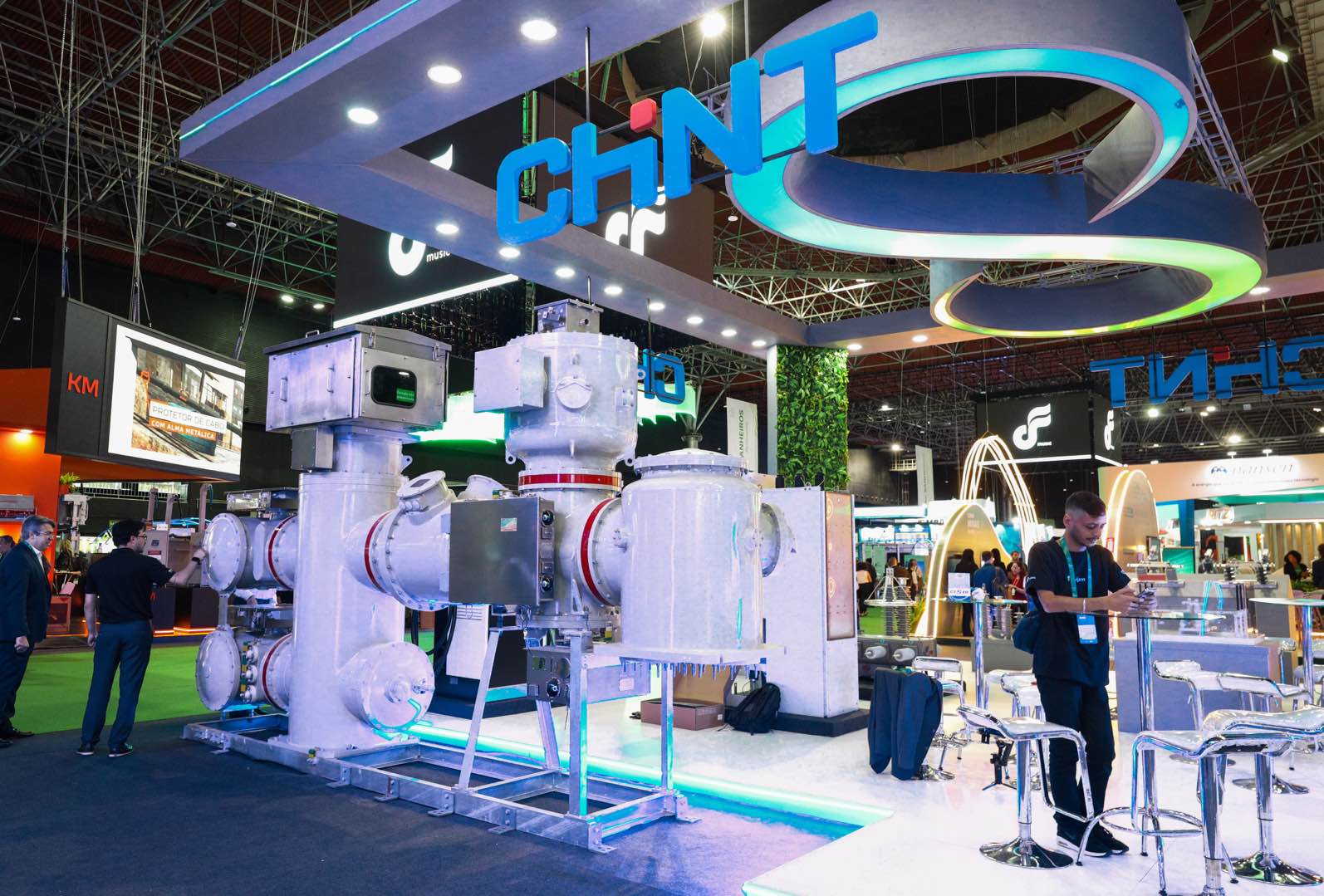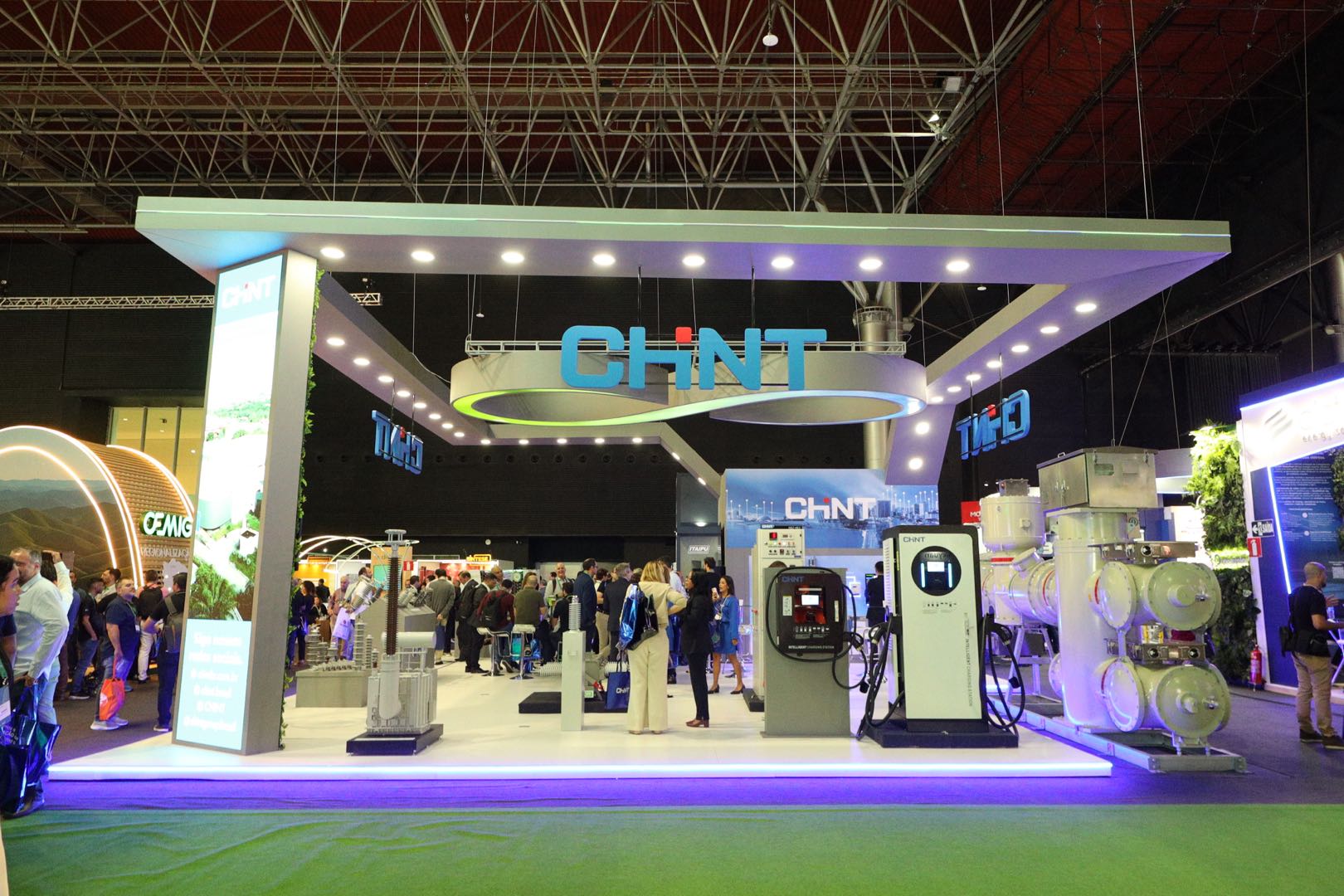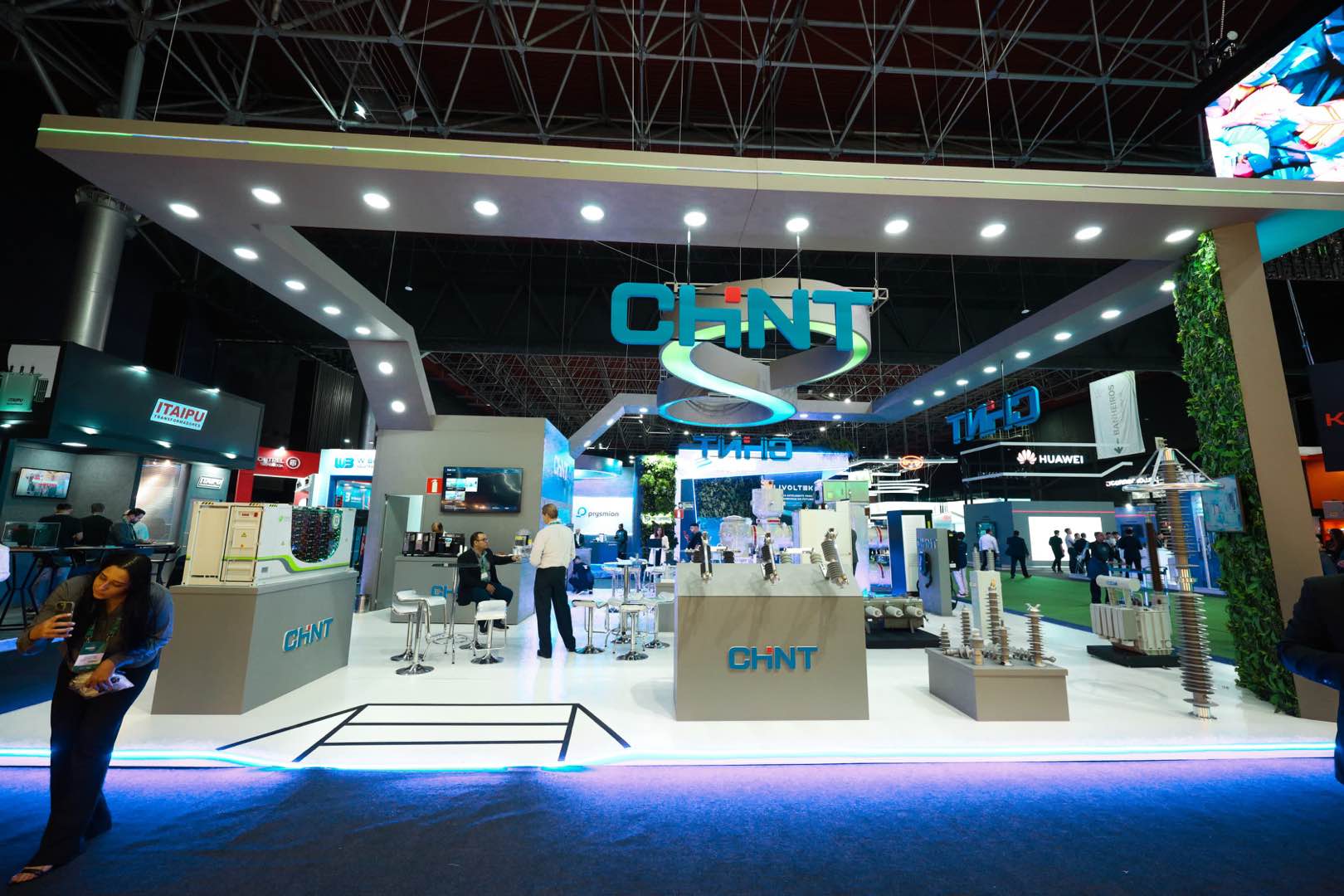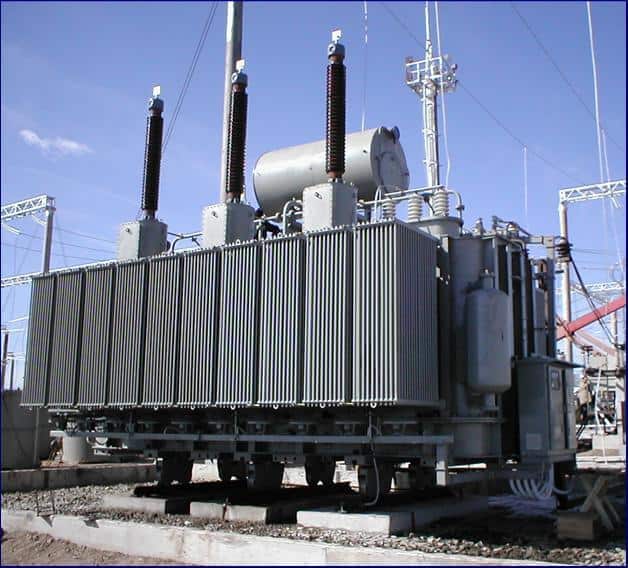CHINT – CHINT wraps up SENDI 2025 showcasing new local meter factory
São Paulo, June 2025 – CHINT concluded its participation in SENDI 2025 – Latin America’s largest electrical power distribution event – with significant achievements and major advances in industry relationships.
Held from May 27th to 30th in Belo Horizonte (MG), the event brought together professionals and decision-makers from Brazil’s leading power utility companies.

It served as a strategic platform for CHINT to solidify its presence in the Brazilian market and showcase its new meter manufacturing plant located in the Manaus Free Trade Zone (AM).
During the four days of SENDI 2025, CHINT presented its energy distribution solutions to attendees, physically displaying equipment such as surge arresters, insulators, a sustainable highlight – a vegetable-oil transformer – and even a replica of a GIS (Gas-Insulated Switchgear) substation.

The participation underscored the company’s commitment to providing the Brazilian market with a complete, efficient, and reliable portfolio. A key highlight was the announcement of the new industrial plant in Manaus, dedicated to the domestic production of smart meters.
This initiative strengthens the local supply chain and contributes to advancing Brazil’s energy infrastructure, with the added benefit of creating over 350 jobs in the region by 2027.

“CHINT’s participation in SENDI 2025 exceeded our expectations. We had the opportunity to showcase our investments in the country firsthand, including our new meter factory, and to strengthen partnerships with Brazilian utilities.
SENDI is undoubtedly the premier industry gathering, and being here was essential to reaffirm our commitment to developing the sector across Brazil,” stated the CEO of CHINT Brazil.

With a prominent presence throughout the event, CHINT positioned itself as a strategic partner for power distributors, offering comprehensive solutions tailored to local demands and aligned with innovation and sustainability principles.
SourceCHINT
EMR Analysis
More information on CHINT: See the full profile on EMR Executive Services
More information on Nan Cunhui (Chairman, Zhengtai Group + Chairman, CHINT Group): See the full profile on EMR Executive Services
More information on Lily Zhang (Executive President, CHINT Electric + President and Chief Executive Officer, CHINT Global): See the full profile on EMR Executive Services
More information on the XXV National Electric Energy Distribution Seminar (SENDI) 2025 (26 to 30 May, 2025 – Belo Horizonte, MG, Brazil): https://sendi.org.br/ + This is the meeting place for the Electricity Distribution Market.
Held every two years, the National Seminar on Electric Energy Distribution – SENDI – is today the largest electricity distribution event in Latin America.
EMR Additional Notes:
- Power Utility:
- Also known as an electric utility or power company, is a company or entity responsible for generating, transmitting, and distributing electricity to consumers. They often operate in regulated markets and are major providers of energy in most countries.
- Smart Metering:
- Smart metering is the monitoring of resource consumption, such as energy, water, gas, etc., through modern metering devices connected to the Internet via IoT technology.
- Advantages: Eliminates manual monthly meter readings. Monitors the electric system in real time. Encourages more efficient use of power resources. Provides responsive data for balancing electric loads while reducing blackouts. Enables dynamic pricing.
- Surge, Transient, Earth and Lightning Protection / Arresters Devices:
- Surge:
- Sudden increase in voltage that lasts for three nanoseconds or more is called a voltage surge.
- Surge protector are also known as Transient Voltage Surge Suppressor (TVSS), Surge Protection Devices (SPD) or Surge Suppression Equipment (SSE). These are equipments designed to protect electrical and electronic equipment from power surges and voltage spikes.
- A surge protector limits the voltage supplied to the electrical devices to a certain threshold, by short-circuiting current to ground or absorbing the spike when a transient occurs, thus avoiding damage to the devices connected to it.
- A surge protector does not interrupt the flow of power. It simply diverts it until the voltage returns to normal. While surge arresters also do this, they often come equipped with a crowbar circuit that acts as a failsafe. If there is a malfunction, the crowbar will interrupt the current.
- Sudden increase in voltage that lasts for three nanoseconds or more is called a voltage surge.
- Transient:
- Temporary unwanted voltage in an electrical circuit that range from a few volts to several thousand volts and last micro seconds up to a few milliseconds.
- => Surge vs. Transient:
- Surges are generally of longer duration but have lower peak voltage and/or current amplitude, while transients are of shorter duration and, usually, higher peak amplitude.
- Earthing and Lighting:
- Earthing ensures that any electrical faults are safely directed to the ground, minimizing the risk of damage or injury usually done by driving ground rods or a horizontal grid of near surface bare conductors under the ground.
- Lightning protection is a system of devices and components designed to protect a building and its occupants from the damaging effects of lightning strikes.
- Surge:
- Insulator:
- An electric insulator (also known as a dielectric material) is a substance or object that does not readily allow the flow of electric current through it.

- Substation:
- A power station is where the power is generated. A sub station is where power is split apart, distributed and spread further into the grid. A substation is a part of an electrical generation, transmission, and distribution system.
- Substations contain the specialist equipment that allows the voltage of electricity to be transformed (or ‘switched’). The voltage is stepped up or down through pieces of equipment called transformers, which sit within a substation’s site.
- Substations typically include:
- Transformers: The core components for voltage transformation.
- Circuit Breakers: To isolate and protect equipment.
- Switchgear: For controlling and protecting the flow of electricity.
- Shunt Reactors (sometimes): Used to improve system stability.
- Other equipment: Measuring instruments, control panels, etc.
- Transformers (Distribution Transformers, Power Transformers, Traction Transformers, HVDC Converters, Solid State Transformers (SST), Rectifier Transformers):
- A distribution transformer is the type of transformer that performs the last voltage transformation in a distribution grid. It converts the voltage used in the transmission lines to one suitable for household and commercial use, typically down to 240 volts.
- The transformer is classified into three types based on the voltage level produced: Step down, Step up, and an isolation transformer.
- Transformers changes from high voltage to low voltage, used in homes and businesses. The main function of this is to reduce the voltage to provide isolation between the two windings as primary and secondary. This transformer distributes electricity to remote areas generated from power plants.
- While transformer stations are linked to high/medium-voltage transmission systems, electrical substations are designed to support and transform lower voltages.
- Distribution transformers always operate at a load less the rated full load. Power transformers always operate at full load. Distribution transformers are designed to give maximum efficiency at 60 to 70% of the rated load. Power transformers have maximum efficiency at full load.
- Power Transformers are used in transmission network of higher voltages for step-up and step down application (400 kV, 200 kV, 110 kV, 66 kV, 33kV) and are generally rated above 200MVA.
- Distribution Transformers are used for lower voltage distribution networks as a means to end user connectivity. (11kV, 6.6 kV, 3.3 kV, 440V, 230V) and are generally rated less than 200 MVA.
- Traction transformers are special transformers used in railway systems to step down high-voltage AC power from the overhead catenary to the required voltage for the train’s traction system. These transformers are typically medium-frequency transformers with ratings ranging from 25 kVA to 25 MVA.
- In HVDC station, the converter transformer steps-up the generated AC voltages to the required level. The converter station takes the electric power from the three-phase AC network and rectifies it to DC, which is then transmitted through overhead lines (or cables).
- A solid state transformer (SST) is an ac–ac converter that can replace conventional transformers used in distribution systems. SST is also known as power electronic transformer (PET) or intelligent universal transformer (IUT). SST uses power electronic converters in conjunction with a high-frequency transformer, actively controls voltage and current and operates at high frequencies, allowing for smaller transformer size.
- Rectifier Transformer provides an AC output that is then converted into DC by the rectifier. The transformer’s design helps to ensure that the resulting DC is as smooth and stable as possible. Rectifier transformers are used in industrial processes that require large amounts of DC power.

- Shunt Reactor:
- Shunt reactors (SRs) are used in high voltage energy transmission systems to control the voltage during load variations. Depending on the voltage requirement needs, shunt reactors are switched on or off to provide reactive power compensation.
- A shunt reactor is an absorber of reactive power, thus, increasing the energy efficiency of the system. It is the most compact device commonly used for reactive power compensation in long high-voltage transmission lines and in cable systems. The shunt reactor can be directly connected to the power line or to a tertiary winding of a three-winding transformer. The shunt reactor could be permanently connected or switched via a circuit breaker.
- Shunt reactor is same as power transformer but it has only one winding per phase as compared to power transformer. Shunt reactors are used to increase the power and energy system efficiency as it absorb & compensate the reactive power in cables and long high voltage transmission lines.

- Switchgears:
- Broad term that describes a wide variety of switching devices that all fulfill a common need: controlling, protecting, and isolating power systems. This definition can be extended to include devices to regulate and meter a power system, circuit breakers, and similar technology.
- Switchgear contains fuses, switches, and other power conductors. However, circuit breakers are the most common component found in switchgear.
- Performs the function of controlling and metering the flow of electrical power in addiction to acting as interrupting and switching devices that protects the equipment from damage arising out of electrical fluctuations.
- There are three types of switch gears namely LV (Low voltage), MV (Medium voltage) and HV (High voltage) Switchgear.
- Circuit Breakers:
- Mechanical electrical switch designed to protect an electrical circuit from damage caused by overcurrent/overload or short circuit. Its basic function is to interrupt current flow after protective relays detect a fault.
- By definition a circuit breaker is an electrical safety device, a switch that automatically interrupts the current of an overloaded electric circuit, ground faults, or short circuits.
- Fuses:
- Single time mechanical circuit interruption in an over-current situation through fusion of a graded electrical conductor. Employed in 30KV to 100KV range.
- Electrical safety device that operates to provide overcurrent protection of an electrical circuit. Its essential component is a metal wire or strip that melts when too much current flows through it, thereby stopping or interrupting the current.
- Fuse Switch-Disconnector:
- Fuse switch disconnector combines the functions of a fuse and a switch disconnector; It provides overcurrent protection like a fuse, and it also allows for manual disconnection of the circuit for isolation purposes.
- ACB (Air Circuit Breakers):
- Uses air as insulating medium.
- Air circuit breaker is a circuit breaker for the purpose of protecting low voltage circuit, mainly for energizing and cutting off high current
- VCB (Vacuum Circuit Breakers):
- Vacuum is used as the means to protect circuit breakers.
- Circuit breaker where the arc quenching takes place in a vacuum medium. The operation of switching on and closing of current carrying contacts and interrelated arc interruption takes place in a vacuum chamber in the breaker which is called a vacuum interrupter.
- AIS (Air Insulated Switchgears):
- Air is used for insulation in a metal-clad system
- Secondary power distribution device and medium voltage switchgear that helps redistribute the power of a primary power distributor powered by a high voltage distribution transformer. AIS controls, protects and isolates electrical equipment in power transmission and distribution systems.
- GIS (Gas Insulated Switchgears):
- All working components assembled under SF6 (Sulfur Hexafluoride HV Switchgears) gas-tight casing.
- Compact metal encapsulated switchgear consisting of high-voltage components such as circuit-breakers and disconnectors, which can be safely operated in confined spaces.
- OCB (Oil Circuit Breakers):
- Vapors a portion of oil to blast a jet of oil through the arc.
- Circuit breaker which uses insulating oil as an arc quenching medium
- Hybrid Circuit Breakers:
- Combines Air-insulated and SF6 Gas-insulated technologies.
- MCB (Miniature Circuit Breakers):
- Employed in domestic households to safeguard against overload. Rated current max. 100 A.
- Electrical switch that automatically switches off the electrical circuit during an abnormal condition of the network means an overload condition as well as a faulty condition. Nowadays we use an MCB in a low-voltage electrical network instead of a fuse.
- Circuit breakers have a tripping relay mechanism, while MCB has a tripping release mechanism. Circuit breakers have a high rupturing capacity, but the MCB has a low rupturing capacity. Circuit breakers are used in High Voltage systems, while MCBs are used in Low Voltage systems.
- RCCB (Residual Current Circuit Breakers):
- To safeguard against electrical shock arising out of indirect contact and includes the detection of residual current such as earth leakage.
- Current sensing device, which can automatically measure and disconnect the circuit whenever a fault occurs in the connected circuit or the current exceeds the rated sensitivity.
- MCCB (Molded Case Circuit Breakers):
- Incorporates insulating material in the form of molded casing within circuit breaker. Rated current up to 2,500 A.
- MCCB has a higher interrupting capacity, meaning it can handle larger loads than a conventional breaker. Generally, a standard breaker is used for residential and light commercial applications, while an MCCB is suitable for industrial and heavy commercial applications.
- Disconnectors:
- Automatic switching device that offers specific isolating distance on the basis of specific requirements.
- Disconnectors (also known as Isolators) are devices which are generally operated off-load to provide isolation of main plant items for maintenance, or to isolate faulted equipment from other live equipment.
- Contactors:
- Works alike high-current switching systems but at higher voltage rates. Contactors can however not be utilized as disconnecting switches. Contactors are employed in 30KV to 100KV range.
- Special type of relay used for switching an electrical circuit on or off.
- Electrical device that is widely used for switching circuits on and off. As such, electrical contactors form a subcategory of electromagnetic switches known as relays. A relay is an electrically operated switching device that uses an electromagnetic coil to open and close a set of contacts.
- PTCB eFuse Circuit Breaker:
- Electronic micro fuse for DIN rail protecting electronically nominal currents below 1A to facilitate the clear detection of faults and supports precise fault localization and fast recovery. Response times are shorter compared to conventional fuse protection and the exact current value can be adjusted at any time
- RCD (Residual Current Devices):
- Sensitive safety device that switches off the electricity within 10 to 50 milliseconds if there is an electrical fault. An RCD is is designed to protect against the risks of electrocution and fire caused by earth faults.
- The difference between a circuit breaker and an RCD switch is the purpose of a circuit breaker is to protect the electrical systems and wiring in a home while the purpose of an RCD switch is to protect people from electrocution.
- RCBO (Residual Current Breaker with Over-Current):
- RCDs can protect against electric shocks, residual currents, and earth faults. On the other hand, RCBOs can do what RCDs can do and protect a circuit from short circuits and overload. RCBOs are essentially a combination of MCB and RCCB.
- An RCBO protects electrical equipment from two types of faults; residual current and over current. Residual current, or Earth leakage as it can sometimes be referred to, is when there is a break in the circuit that could be caused by faulty electrical wiring or if the wire is accidentally cut.
- Ring Main Unit (RMU):
- Medium voltage, gas-insulated, fully sealed cabinet used to measure, connect, and integrate transformer protection functions with a fixed type breaker. Ring Main Units are safe, reliable, low-maintenance, and easy to replace switchgear.
- A ring main unit (RMU) is a factory assembled, metal enclosed set of switchgear used at the load connection points of a ring-type distribution network.
- Load Center – Panel Board – Switch Board – Distribution Cabinet – Distribution Box – Distribution Enclosure:
- A load center is used in residential and light commercial applications to distribute electricity supplied by the utility company throughout the home or building to feed all the branch circuits. Each branch circuit is protected by the circuit breaker housed in the load center. In the event of a short circuit or an overload on a branch circuit, the circuit breaker will cut the power before any potential property damage or personal injury can occur.
- A load center provides similar functionality in a power distribution system as a switchboard and a panelboard. As far as UL and the NEC standards are concerned, there is no difference between a panelboard and a load center. The term Panel Board is more used in commercial and industrial applications.
- However, Panelboards are typically deeper than load centers and can accommodate both bolt-on circuit breakers as well as plug-in breakers, whereas a load center is limited to plug-in breakers.
- Switchboards are often the typical choice for large commercial and industrial establishments. These panelboards generally house circuit breakers that can manage and supply electricity for machines with high-voltage demands.
- Panelboards are only accessible from the front (as mentioned above), but switchboards allow rear access as well.
- Distribution cabinet is used as a general term for an enclosure that houses electrical distribution components. It can refer to enclosures containing panelboards, switchboards, or other distribution equipment.
- In terms of use, distribution boxes are generally used for households (smaller enclosures), and distribution cabinets are mostly used for centralized power supply. Distribution boxes and cabinets are complete sets of equipment. Distribution boxes are low-voltage complete sets of equipment. Cabinets have both high and low voltages.
- An enclosure or distribution enclosure in a general term for any type of protective housing for electrical distribution components. It’s essentially a cabinet or box designed to safeguard components from environmental factors, prevent electrical shock, and potentially shield against electromagnetic interference.

- Solid-State Circuit Breakers:
- Solid-state device, electronic device in which electricity flows through solid semiconductor crystals (silicon, gallium arsenide, germanium) rather than through vacuum tubes.
- The solid-state breaker concept replaces the traditional moving parts of an electromechanical circuit breaker with semiconductors and advanced software algorithms that control the power and can interrupt extreme currents faster than ever before.
- Pad-mount Switchgear:
- The pad-mount switchgear is made from the same modular switch and interrupter components as the vault switchgear. This means all components are sealed, submersible and protected, so you don’t have to worry about tracking, animal infestation, corrosion or the effects of condensation inside the enclosure.
- Supply Chain:
- Network of all the individuals, organizations, resources, activities and technology involved in the creation and sale of a product. A supply chain encompasses everything from the delivery of source materials from the supplier to the manufacturer through to its eventual delivery to the end user.
- At the most fundamental level, supply chain management (SCM) is management of the flow of goods, data, and finances related to a product or service, from the procurement of raw materials to the delivery of the product at its final destination.

